PUBH6004 - Leadership and Effecting Change in Public Health Report
VerifiedAdded on 2022/09/01
|10
|2980
|32
Report
AI Summary
This report provides a comprehensive analysis of a public health leadership case study, focusing on a newly elected public health officer, Helen, in Warnambool, Victoria. The analysis applies several public health leadership theories, including personal and civic leadership, trait theory, transformational theory, leadership-member exchange theory, and adaptive leadership, within the context of the Australian Health Leadership Framework. The report examines Helen's challenges, such as dealing with a patriarchal society and the lack of specialist care, and discusses the applicability of different leadership styles. It includes a self-assessment section, evaluating leadership strengths and weaknesses, and concludes with an action plan outlining strategies to address community health concerns and improve public health policies. The report emphasizes the importance of community involvement and the role of effective leadership in the public health sector.
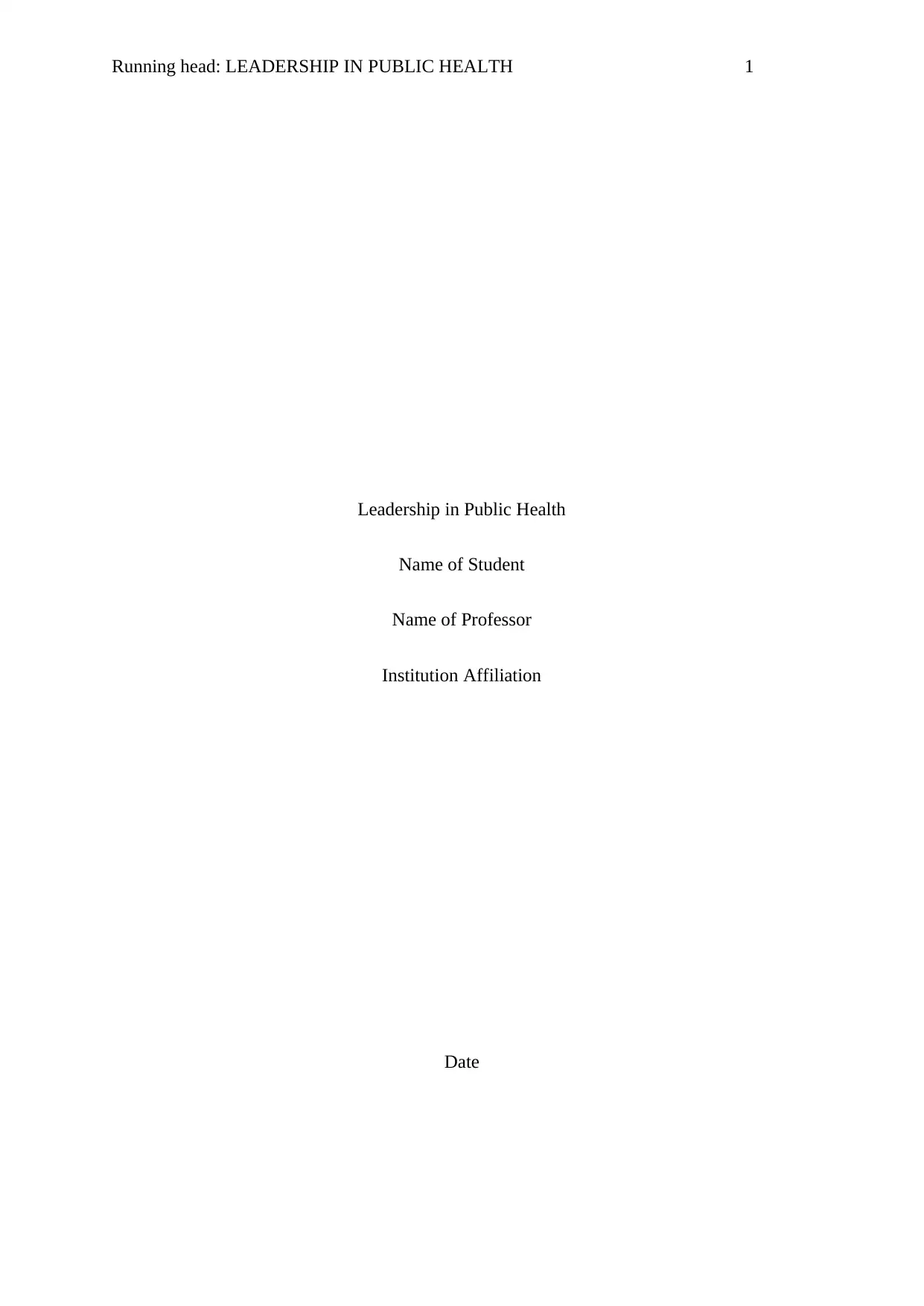
Running head: LEADERSHIP IN PUBLIC HEALTH 1
Leadership in Public Health
Name of Student
Name of Professor
Institution Affiliation
Date
Leadership in Public Health
Name of Student
Name of Professor
Institution Affiliation
Date
Paraphrase This Document
Need a fresh take? Get an instant paraphrase of this document with our AI Paraphraser
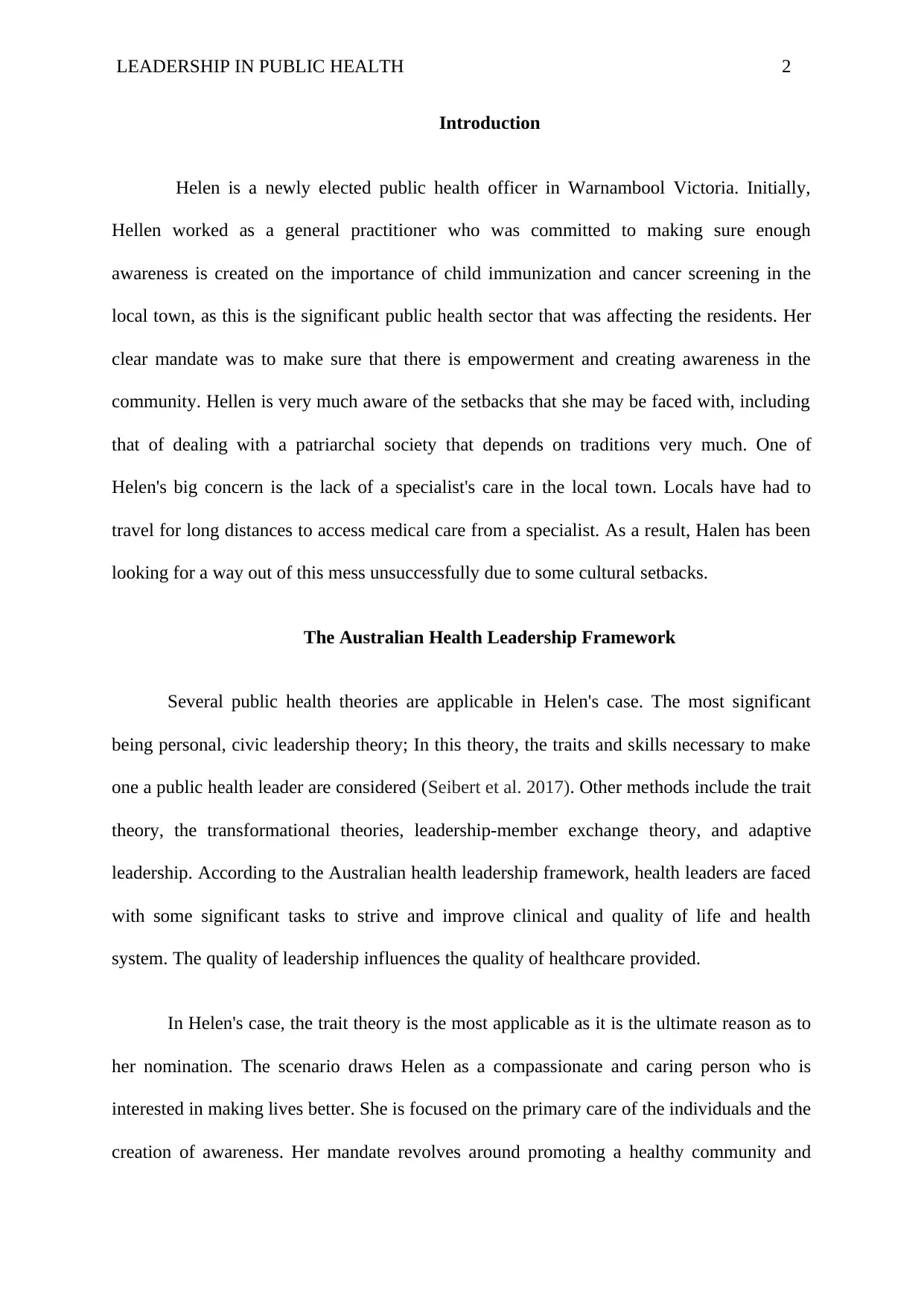
LEADERSHIP IN PUBLIC HEALTH 2
Introduction
Helen is a newly elected public health officer in Warnambool Victoria. Initially,
Hellen worked as a general practitioner who was committed to making sure enough
awareness is created on the importance of child immunization and cancer screening in the
local town, as this is the significant public health sector that was affecting the residents. Her
clear mandate was to make sure that there is empowerment and creating awareness in the
community. Hellen is very much aware of the setbacks that she may be faced with, including
that of dealing with a patriarchal society that depends on traditions very much. One of
Helen's big concern is the lack of a specialist's care in the local town. Locals have had to
travel for long distances to access medical care from a specialist. As a result, Halen has been
looking for a way out of this mess unsuccessfully due to some cultural setbacks.
The Australian Health Leadership Framework
Several public health theories are applicable in Helen's case. The most significant
being personal, civic leadership theory; In this theory, the traits and skills necessary to make
one a public health leader are considered (Seibert et al. 2017). Other methods include the trait
theory, the transformational theories, leadership-member exchange theory, and adaptive
leadership. According to the Australian health leadership framework, health leaders are faced
with some significant tasks to strive and improve clinical and quality of life and health
system. The quality of leadership influences the quality of healthcare provided.
In Helen's case, the trait theory is the most applicable as it is the ultimate reason as to
her nomination. The scenario draws Helen as a compassionate and caring person who is
interested in making lives better. She is focused on the primary care of the individuals and the
creation of awareness. Her mandate revolves around promoting a healthy community and
Introduction
Helen is a newly elected public health officer in Warnambool Victoria. Initially,
Hellen worked as a general practitioner who was committed to making sure enough
awareness is created on the importance of child immunization and cancer screening in the
local town, as this is the significant public health sector that was affecting the residents. Her
clear mandate was to make sure that there is empowerment and creating awareness in the
community. Hellen is very much aware of the setbacks that she may be faced with, including
that of dealing with a patriarchal society that depends on traditions very much. One of
Helen's big concern is the lack of a specialist's care in the local town. Locals have had to
travel for long distances to access medical care from a specialist. As a result, Halen has been
looking for a way out of this mess unsuccessfully due to some cultural setbacks.
The Australian Health Leadership Framework
Several public health theories are applicable in Helen's case. The most significant
being personal, civic leadership theory; In this theory, the traits and skills necessary to make
one a public health leader are considered (Seibert et al. 2017). Other methods include the trait
theory, the transformational theories, leadership-member exchange theory, and adaptive
leadership. According to the Australian health leadership framework, health leaders are faced
with some significant tasks to strive and improve clinical and quality of life and health
system. The quality of leadership influences the quality of healthcare provided.
In Helen's case, the trait theory is the most applicable as it is the ultimate reason as to
her nomination. The scenario draws Helen as a compassionate and caring person who is
interested in making lives better. She is focused on the primary care of the individuals and the
creation of awareness. Her mandate revolves around promoting a healthy community and
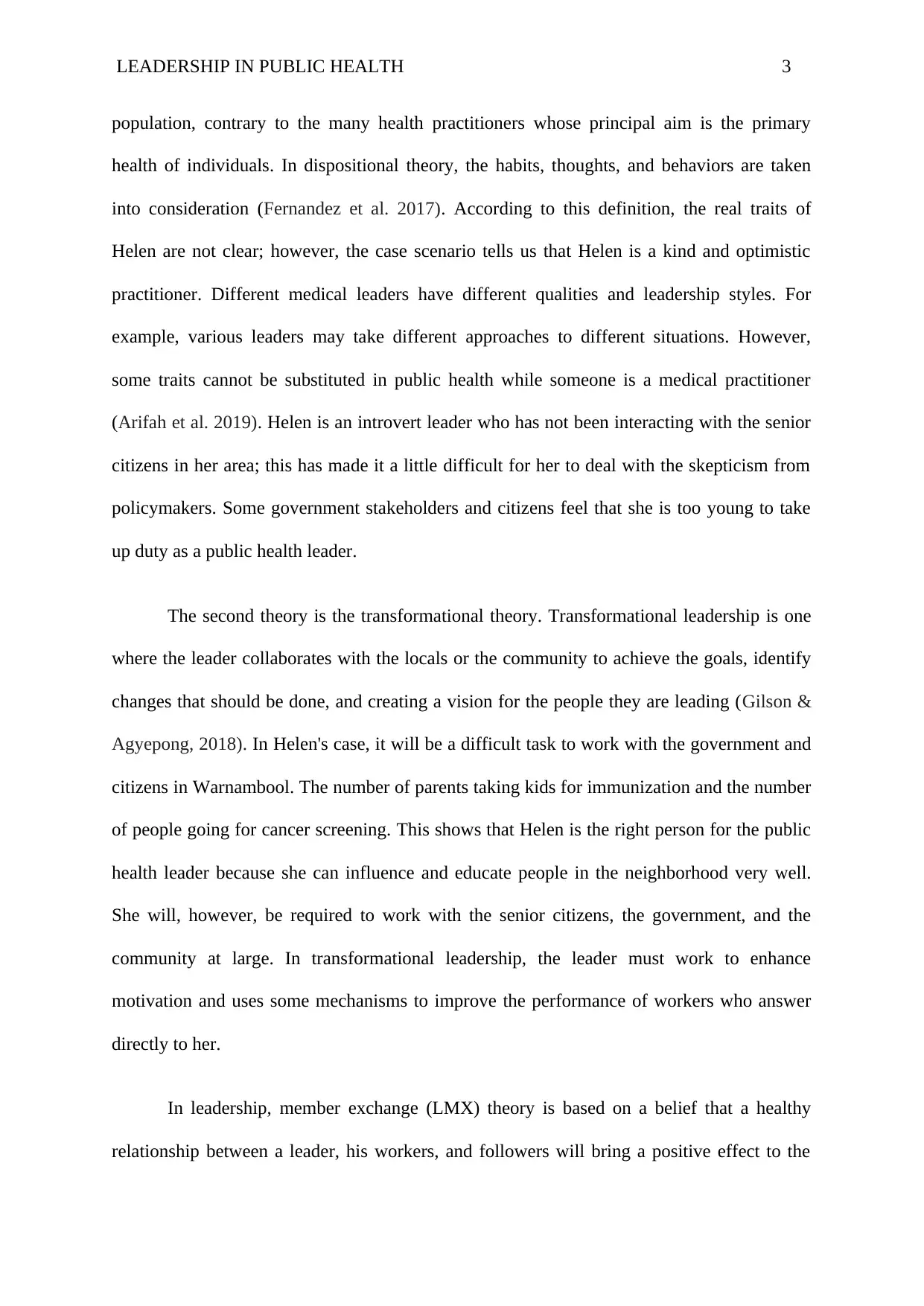
LEADERSHIP IN PUBLIC HEALTH 3
population, contrary to the many health practitioners whose principal aim is the primary
health of individuals. In dispositional theory, the habits, thoughts, and behaviors are taken
into consideration (Fernandez et al. 2017). According to this definition, the real traits of
Helen are not clear; however, the case scenario tells us that Helen is a kind and optimistic
practitioner. Different medical leaders have different qualities and leadership styles. For
example, various leaders may take different approaches to different situations. However,
some traits cannot be substituted in public health while someone is a medical practitioner
(Arifah et al. 2019). Helen is an introvert leader who has not been interacting with the senior
citizens in her area; this has made it a little difficult for her to deal with the skepticism from
policymakers. Some government stakeholders and citizens feel that she is too young to take
up duty as a public health leader.
The second theory is the transformational theory. Transformational leadership is one
where the leader collaborates with the locals or the community to achieve the goals, identify
changes that should be done, and creating a vision for the people they are leading (Gilson &
Agyepong, 2018). In Helen's case, it will be a difficult task to work with the government and
citizens in Warnambool. The number of parents taking kids for immunization and the number
of people going for cancer screening. This shows that Helen is the right person for the public
health leader because she can influence and educate people in the neighborhood very well.
She will, however, be required to work with the senior citizens, the government, and the
community at large. In transformational leadership, the leader must work to enhance
motivation and uses some mechanisms to improve the performance of workers who answer
directly to her.
In leadership, member exchange (LMX) theory is based on a belief that a healthy
relationship between a leader, his workers, and followers will bring a positive effect to the
population, contrary to the many health practitioners whose principal aim is the primary
health of individuals. In dispositional theory, the habits, thoughts, and behaviors are taken
into consideration (Fernandez et al. 2017). According to this definition, the real traits of
Helen are not clear; however, the case scenario tells us that Helen is a kind and optimistic
practitioner. Different medical leaders have different qualities and leadership styles. For
example, various leaders may take different approaches to different situations. However,
some traits cannot be substituted in public health while someone is a medical practitioner
(Arifah et al. 2019). Helen is an introvert leader who has not been interacting with the senior
citizens in her area; this has made it a little difficult for her to deal with the skepticism from
policymakers. Some government stakeholders and citizens feel that she is too young to take
up duty as a public health leader.
The second theory is the transformational theory. Transformational leadership is one
where the leader collaborates with the locals or the community to achieve the goals, identify
changes that should be done, and creating a vision for the people they are leading (Gilson &
Agyepong, 2018). In Helen's case, it will be a difficult task to work with the government and
citizens in Warnambool. The number of parents taking kids for immunization and the number
of people going for cancer screening. This shows that Helen is the right person for the public
health leader because she can influence and educate people in the neighborhood very well.
She will, however, be required to work with the senior citizens, the government, and the
community at large. In transformational leadership, the leader must work to enhance
motivation and uses some mechanisms to improve the performance of workers who answer
directly to her.
In leadership, member exchange (LMX) theory is based on a belief that a healthy
relationship between a leader, his workers, and followers will bring a positive effect to the
⊘ This is a preview!⊘
Do you want full access?
Subscribe today to unlock all pages.

Trusted by 1+ million students worldwide
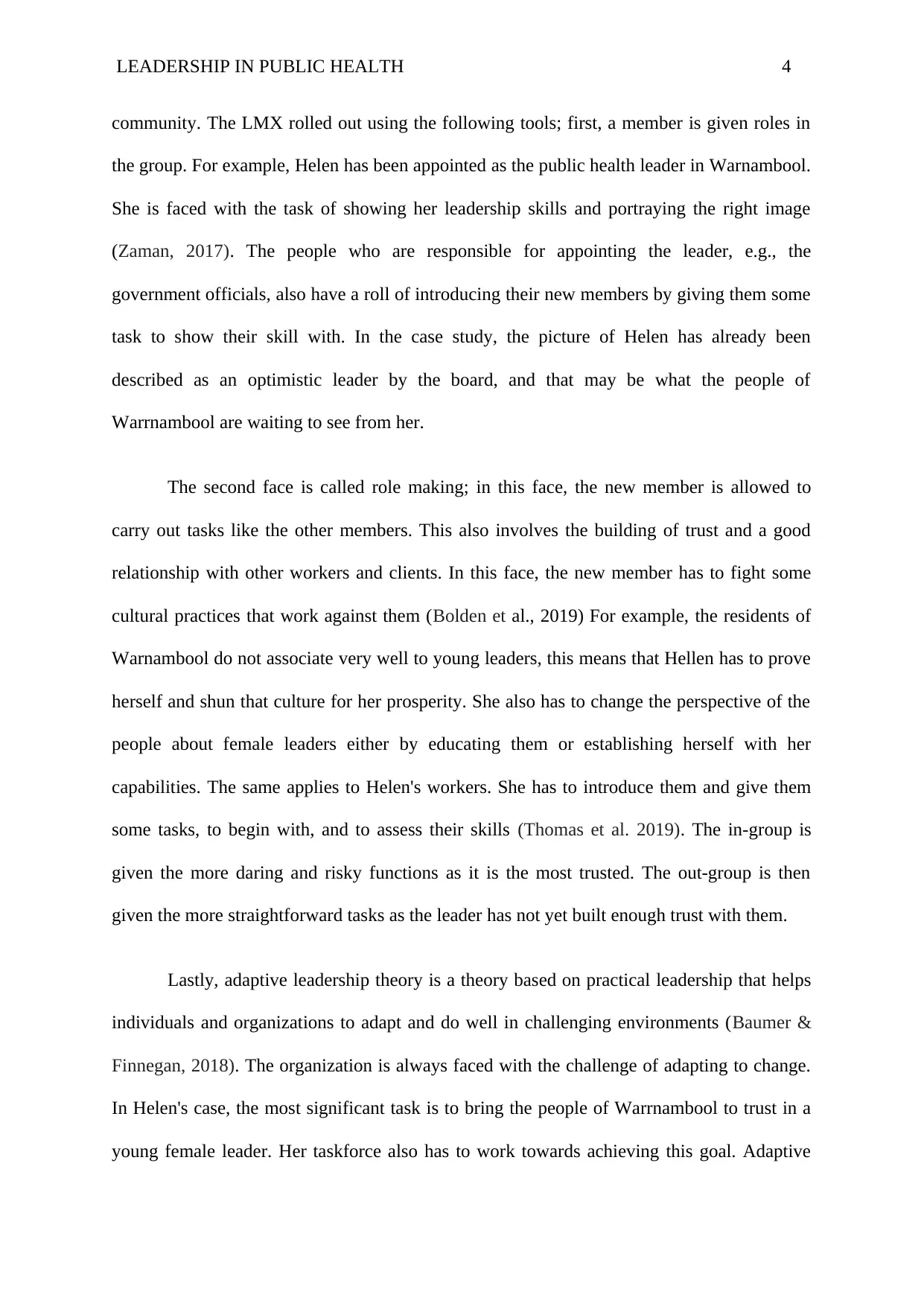
LEADERSHIP IN PUBLIC HEALTH 4
community. The LMX rolled out using the following tools; first, a member is given roles in
the group. For example, Helen has been appointed as the public health leader in Warnambool.
She is faced with the task of showing her leadership skills and portraying the right image
(Zaman, 2017). The people who are responsible for appointing the leader, e.g., the
government officials, also have a roll of introducing their new members by giving them some
task to show their skill with. In the case study, the picture of Helen has already been
described as an optimistic leader by the board, and that may be what the people of
Warrnambool are waiting to see from her.
The second face is called role making; in this face, the new member is allowed to
carry out tasks like the other members. This also involves the building of trust and a good
relationship with other workers and clients. In this face, the new member has to fight some
cultural practices that work against them (Bolden et al., 2019) For example, the residents of
Warnambool do not associate very well to young leaders, this means that Hellen has to prove
herself and shun that culture for her prosperity. She also has to change the perspective of the
people about female leaders either by educating them or establishing herself with her
capabilities. The same applies to Helen's workers. She has to introduce them and give them
some tasks, to begin with, and to assess their skills (Thomas et al. 2019). The in-group is
given the more daring and risky functions as it is the most trusted. The out-group is then
given the more straightforward tasks as the leader has not yet built enough trust with them.
Lastly, adaptive leadership theory is a theory based on practical leadership that helps
individuals and organizations to adapt and do well in challenging environments (Baumer &
Finnegan, 2018). The organization is always faced with the challenge of adapting to change.
In Helen's case, the most significant task is to bring the people of Warrnambool to trust in a
young female leader. Her taskforce also has to work towards achieving this goal. Adaptive
community. The LMX rolled out using the following tools; first, a member is given roles in
the group. For example, Helen has been appointed as the public health leader in Warnambool.
She is faced with the task of showing her leadership skills and portraying the right image
(Zaman, 2017). The people who are responsible for appointing the leader, e.g., the
government officials, also have a roll of introducing their new members by giving them some
task to show their skill with. In the case study, the picture of Helen has already been
described as an optimistic leader by the board, and that may be what the people of
Warrnambool are waiting to see from her.
The second face is called role making; in this face, the new member is allowed to
carry out tasks like the other members. This also involves the building of trust and a good
relationship with other workers and clients. In this face, the new member has to fight some
cultural practices that work against them (Bolden et al., 2019) For example, the residents of
Warnambool do not associate very well to young leaders, this means that Hellen has to prove
herself and shun that culture for her prosperity. She also has to change the perspective of the
people about female leaders either by educating them or establishing herself with her
capabilities. The same applies to Helen's workers. She has to introduce them and give them
some tasks, to begin with, and to assess their skills (Thomas et al. 2019). The in-group is
given the more daring and risky functions as it is the most trusted. The out-group is then
given the more straightforward tasks as the leader has not yet built enough trust with them.
Lastly, adaptive leadership theory is a theory based on practical leadership that helps
individuals and organizations to adapt and do well in challenging environments (Baumer &
Finnegan, 2018). The organization is always faced with the challenge of adapting to change.
In Helen's case, the most significant task is to bring the people of Warrnambool to trust in a
young female leader. Her taskforce also has to work towards achieving this goal. Adaptive
Paraphrase This Document
Need a fresh take? Get an instant paraphrase of this document with our AI Paraphraser
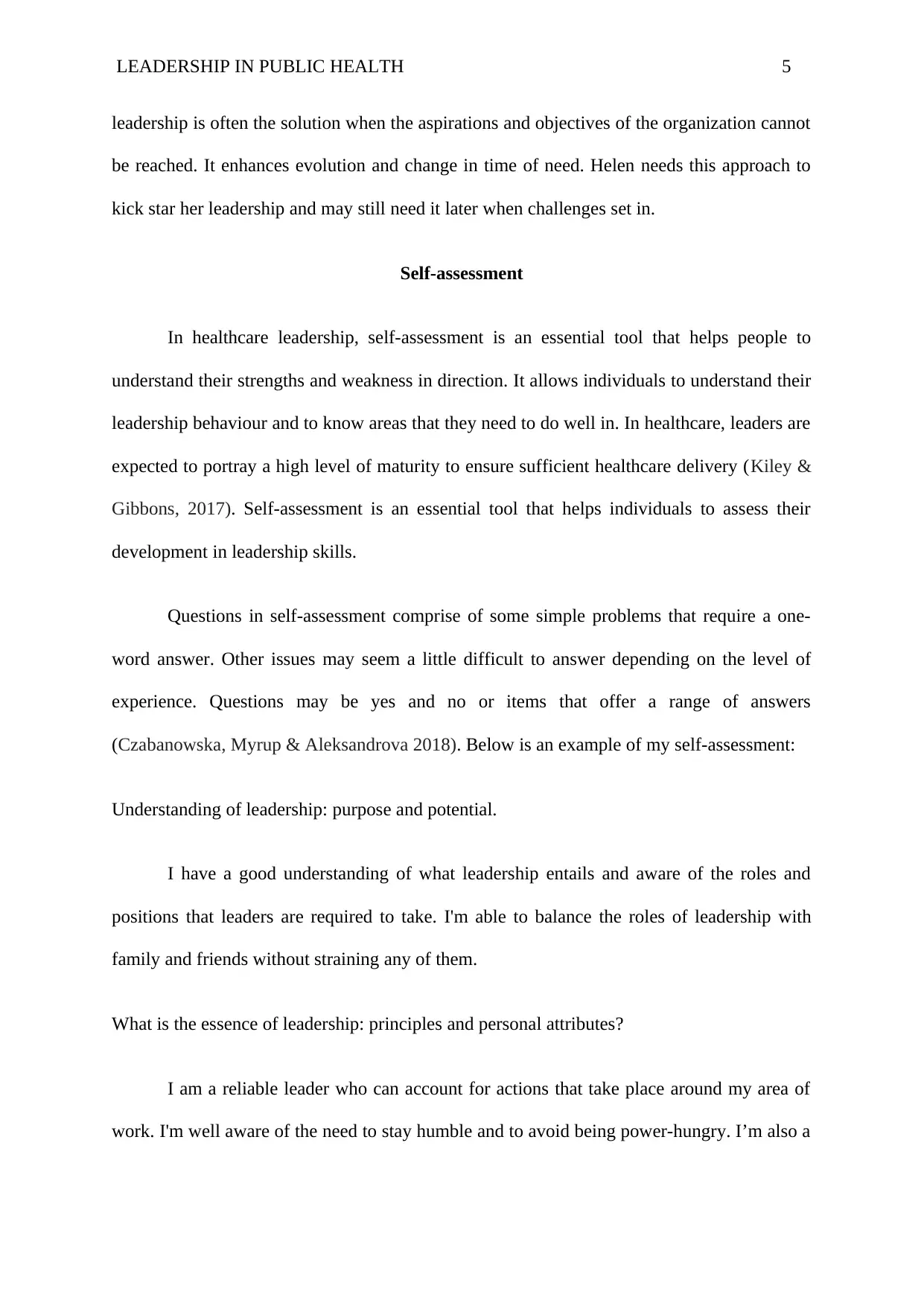
LEADERSHIP IN PUBLIC HEALTH 5
leadership is often the solution when the aspirations and objectives of the organization cannot
be reached. It enhances evolution and change in time of need. Helen needs this approach to
kick star her leadership and may still need it later when challenges set in.
Self-assessment
In healthcare leadership, self-assessment is an essential tool that helps people to
understand their strengths and weakness in direction. It allows individuals to understand their
leadership behaviour and to know areas that they need to do well in. In healthcare, leaders are
expected to portray a high level of maturity to ensure sufficient healthcare delivery (Kiley &
Gibbons, 2017). Self-assessment is an essential tool that helps individuals to assess their
development in leadership skills.
Questions in self-assessment comprise of some simple problems that require a one-
word answer. Other issues may seem a little difficult to answer depending on the level of
experience. Questions may be yes and no or items that offer a range of answers
(Czabanowska, Myrup & Aleksandrova 2018). Below is an example of my self-assessment:
Understanding of leadership: purpose and potential.
I have a good understanding of what leadership entails and aware of the roles and
positions that leaders are required to take. I'm able to balance the roles of leadership with
family and friends without straining any of them.
What is the essence of leadership: principles and personal attributes?
I am a reliable leader who can account for actions that take place around my area of
work. I'm well aware of the need to stay humble and to avoid being power-hungry. I’m also a
leadership is often the solution when the aspirations and objectives of the organization cannot
be reached. It enhances evolution and change in time of need. Helen needs this approach to
kick star her leadership and may still need it later when challenges set in.
Self-assessment
In healthcare leadership, self-assessment is an essential tool that helps people to
understand their strengths and weakness in direction. It allows individuals to understand their
leadership behaviour and to know areas that they need to do well in. In healthcare, leaders are
expected to portray a high level of maturity to ensure sufficient healthcare delivery (Kiley &
Gibbons, 2017). Self-assessment is an essential tool that helps individuals to assess their
development in leadership skills.
Questions in self-assessment comprise of some simple problems that require a one-
word answer. Other issues may seem a little difficult to answer depending on the level of
experience. Questions may be yes and no or items that offer a range of answers
(Czabanowska, Myrup & Aleksandrova 2018). Below is an example of my self-assessment:
Understanding of leadership: purpose and potential.
I have a good understanding of what leadership entails and aware of the roles and
positions that leaders are required to take. I'm able to balance the roles of leadership with
family and friends without straining any of them.
What is the essence of leadership: principles and personal attributes?
I am a reliable leader who can account for actions that take place around my area of
work. I'm well aware of the need to stay humble and to avoid being power-hungry. I’m also a
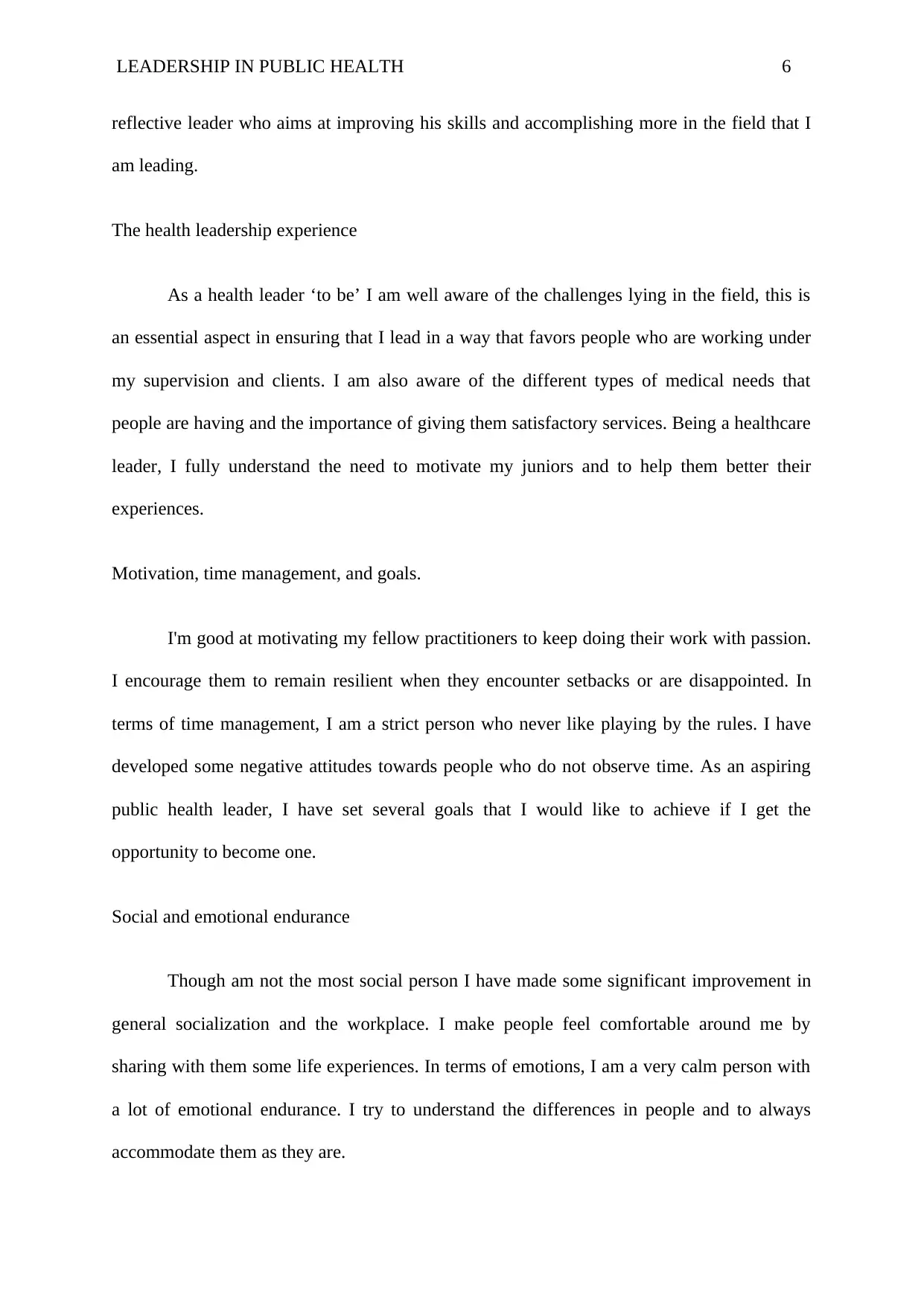
LEADERSHIP IN PUBLIC HEALTH 6
reflective leader who aims at improving his skills and accomplishing more in the field that I
am leading.
The health leadership experience
As a health leader ‘to be’ I am well aware of the challenges lying in the field, this is
an essential aspect in ensuring that I lead in a way that favors people who are working under
my supervision and clients. I am also aware of the different types of medical needs that
people are having and the importance of giving them satisfactory services. Being a healthcare
leader, I fully understand the need to motivate my juniors and to help them better their
experiences.
Motivation, time management, and goals.
I'm good at motivating my fellow practitioners to keep doing their work with passion.
I encourage them to remain resilient when they encounter setbacks or are disappointed. In
terms of time management, I am a strict person who never like playing by the rules. I have
developed some negative attitudes towards people who do not observe time. As an aspiring
public health leader, I have set several goals that I would like to achieve if I get the
opportunity to become one.
Social and emotional endurance
Though am not the most social person I have made some significant improvement in
general socialization and the workplace. I make people feel comfortable around me by
sharing with them some life experiences. In terms of emotions, I am a very calm person with
a lot of emotional endurance. I try to understand the differences in people and to always
accommodate them as they are.
reflective leader who aims at improving his skills and accomplishing more in the field that I
am leading.
The health leadership experience
As a health leader ‘to be’ I am well aware of the challenges lying in the field, this is
an essential aspect in ensuring that I lead in a way that favors people who are working under
my supervision and clients. I am also aware of the different types of medical needs that
people are having and the importance of giving them satisfactory services. Being a healthcare
leader, I fully understand the need to motivate my juniors and to help them better their
experiences.
Motivation, time management, and goals.
I'm good at motivating my fellow practitioners to keep doing their work with passion.
I encourage them to remain resilient when they encounter setbacks or are disappointed. In
terms of time management, I am a strict person who never like playing by the rules. I have
developed some negative attitudes towards people who do not observe time. As an aspiring
public health leader, I have set several goals that I would like to achieve if I get the
opportunity to become one.
Social and emotional endurance
Though am not the most social person I have made some significant improvement in
general socialization and the workplace. I make people feel comfortable around me by
sharing with them some life experiences. In terms of emotions, I am a very calm person with
a lot of emotional endurance. I try to understand the differences in people and to always
accommodate them as they are.
⊘ This is a preview!⊘
Do you want full access?
Subscribe today to unlock all pages.

Trusted by 1+ million students worldwide
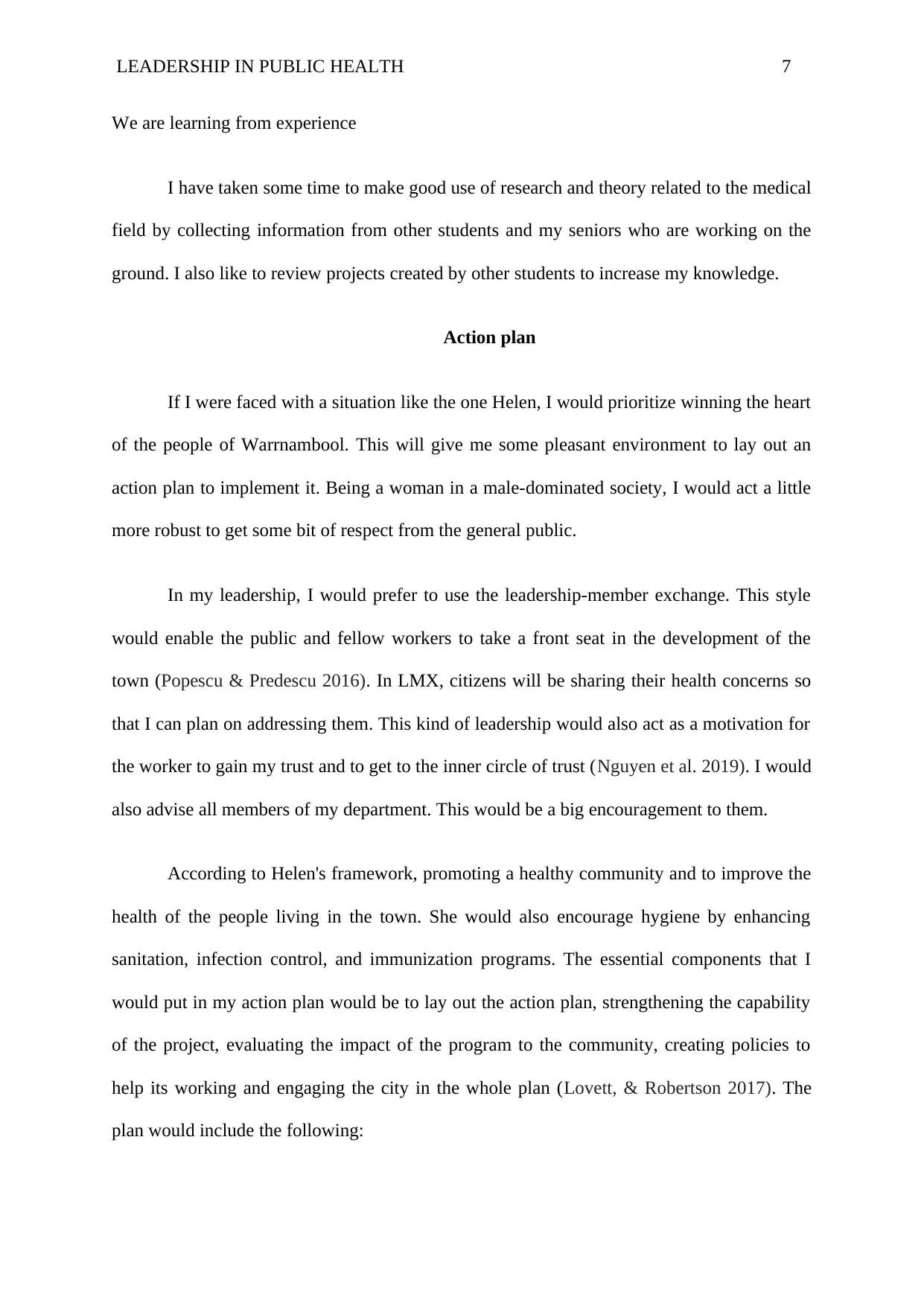
LEADERSHIP IN PUBLIC HEALTH 7
We are learning from experience
I have taken some time to make good use of research and theory related to the medical
field by collecting information from other students and my seniors who are working on the
ground. I also like to review projects created by other students to increase my knowledge.
Action plan
If I were faced with a situation like the one Helen, I would prioritize winning the heart
of the people of Warrnambool. This will give me some pleasant environment to lay out an
action plan to implement it. Being a woman in a male-dominated society, I would act a little
more robust to get some bit of respect from the general public.
In my leadership, I would prefer to use the leadership-member exchange. This style
would enable the public and fellow workers to take a front seat in the development of the
town (Popescu & Predescu 2016). In LMX, citizens will be sharing their health concerns so
that I can plan on addressing them. This kind of leadership would also act as a motivation for
the worker to gain my trust and to get to the inner circle of trust (Nguyen et al. 2019). I would
also advise all members of my department. This would be a big encouragement to them.
According to Helen's framework, promoting a healthy community and to improve the
health of the people living in the town. She would also encourage hygiene by enhancing
sanitation, infection control, and immunization programs. The essential components that I
would put in my action plan would be to lay out the action plan, strengthening the capability
of the project, evaluating the impact of the program to the community, creating policies to
help its working and engaging the city in the whole plan (Lovett, & Robertson 2017). The
plan would include the following:
We are learning from experience
I have taken some time to make good use of research and theory related to the medical
field by collecting information from other students and my seniors who are working on the
ground. I also like to review projects created by other students to increase my knowledge.
Action plan
If I were faced with a situation like the one Helen, I would prioritize winning the heart
of the people of Warrnambool. This will give me some pleasant environment to lay out an
action plan to implement it. Being a woman in a male-dominated society, I would act a little
more robust to get some bit of respect from the general public.
In my leadership, I would prefer to use the leadership-member exchange. This style
would enable the public and fellow workers to take a front seat in the development of the
town (Popescu & Predescu 2016). In LMX, citizens will be sharing their health concerns so
that I can plan on addressing them. This kind of leadership would also act as a motivation for
the worker to gain my trust and to get to the inner circle of trust (Nguyen et al. 2019). I would
also advise all members of my department. This would be a big encouragement to them.
According to Helen's framework, promoting a healthy community and to improve the
health of the people living in the town. She would also encourage hygiene by enhancing
sanitation, infection control, and immunization programs. The essential components that I
would put in my action plan would be to lay out the action plan, strengthening the capability
of the project, evaluating the impact of the program to the community, creating policies to
help its working and engaging the city in the whole plan (Lovett, & Robertson 2017). The
plan would include the following:
Paraphrase This Document
Need a fresh take? Get an instant paraphrase of this document with our AI Paraphraser
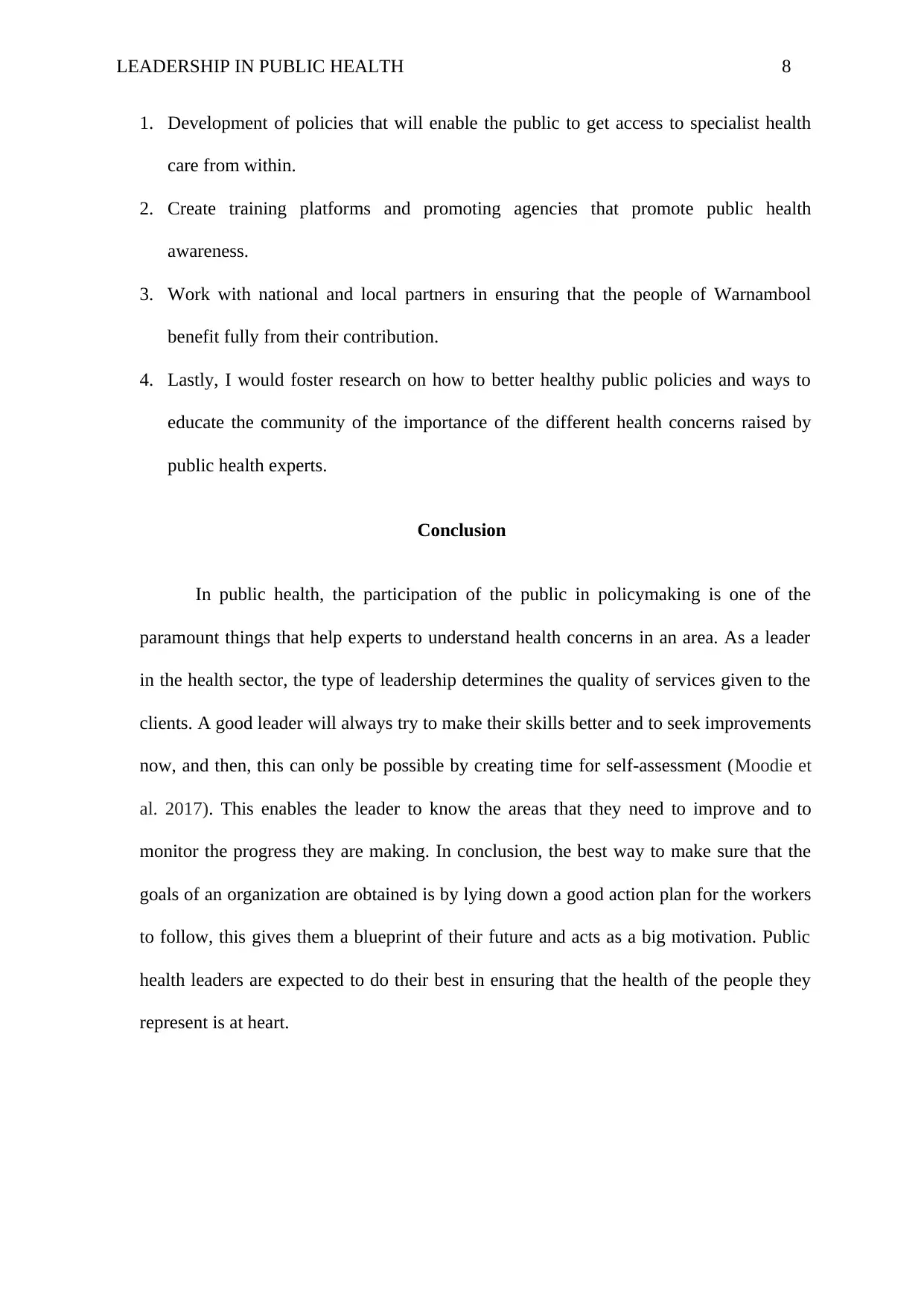
LEADERSHIP IN PUBLIC HEALTH 8
1. Development of policies that will enable the public to get access to specialist health
care from within.
2. Create training platforms and promoting agencies that promote public health
awareness.
3. Work with national and local partners in ensuring that the people of Warnambool
benefit fully from their contribution.
4. Lastly, I would foster research on how to better healthy public policies and ways to
educate the community of the importance of the different health concerns raised by
public health experts.
Conclusion
In public health, the participation of the public in policymaking is one of the
paramount things that help experts to understand health concerns in an area. As a leader
in the health sector, the type of leadership determines the quality of services given to the
clients. A good leader will always try to make their skills better and to seek improvements
now, and then, this can only be possible by creating time for self-assessment (Moodie et
al. 2017). This enables the leader to know the areas that they need to improve and to
monitor the progress they are making. In conclusion, the best way to make sure that the
goals of an organization are obtained is by lying down a good action plan for the workers
to follow, this gives them a blueprint of their future and acts as a big motivation. Public
health leaders are expected to do their best in ensuring that the health of the people they
represent is at heart.
1. Development of policies that will enable the public to get access to specialist health
care from within.
2. Create training platforms and promoting agencies that promote public health
awareness.
3. Work with national and local partners in ensuring that the people of Warnambool
benefit fully from their contribution.
4. Lastly, I would foster research on how to better healthy public policies and ways to
educate the community of the importance of the different health concerns raised by
public health experts.
Conclusion
In public health, the participation of the public in policymaking is one of the
paramount things that help experts to understand health concerns in an area. As a leader
in the health sector, the type of leadership determines the quality of services given to the
clients. A good leader will always try to make their skills better and to seek improvements
now, and then, this can only be possible by creating time for self-assessment (Moodie et
al. 2017). This enables the leader to know the areas that they need to improve and to
monitor the progress they are making. In conclusion, the best way to make sure that the
goals of an organization are obtained is by lying down a good action plan for the workers
to follow, this gives them a blueprint of their future and acts as a big motivation. Public
health leaders are expected to do their best in ensuring that the health of the people they
represent is at heart.
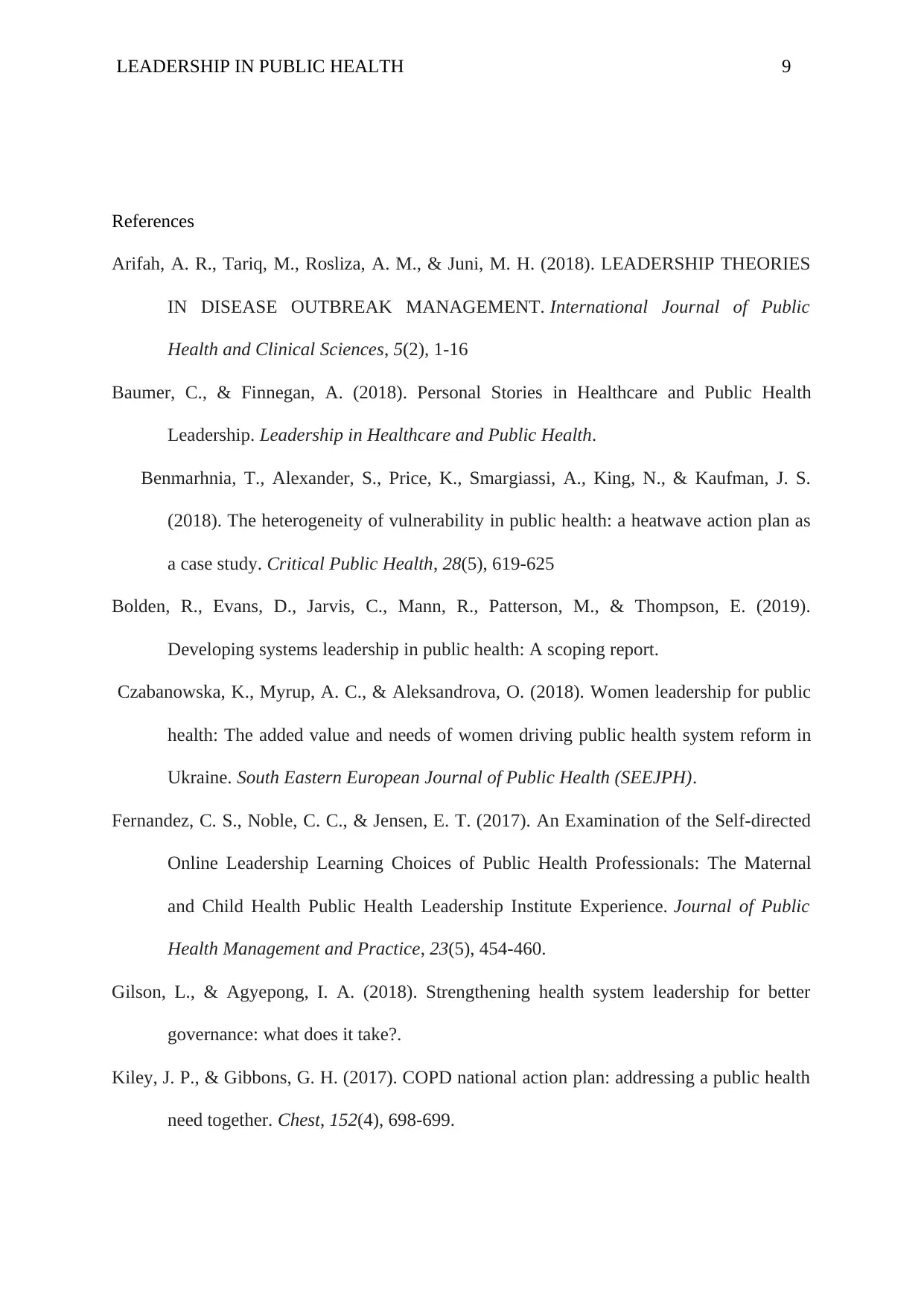
LEADERSHIP IN PUBLIC HEALTH 9
References
Arifah, A. R., Tariq, M., Rosliza, A. M., & Juni, M. H. (2018). LEADERSHIP THEORIES
IN DISEASE OUTBREAK MANAGEMENT. International Journal of Public
Health and Clinical Sciences, 5(2), 1-16
Baumer, C., & Finnegan, A. (2018). Personal Stories in Healthcare and Public Health
Leadership. Leadership in Healthcare and Public Health.
Benmarhnia, T., Alexander, S., Price, K., Smargiassi, A., King, N., & Kaufman, J. S.
(2018). The heterogeneity of vulnerability in public health: a heatwave action plan as
a case study. Critical Public Health, 28(5), 619-625
Bolden, R., Evans, D., Jarvis, C., Mann, R., Patterson, M., & Thompson, E. (2019).
Developing systems leadership in public health: A scoping report.
Czabanowska, K., Myrup, A. C., & Aleksandrova, O. (2018). Women leadership for public
health: The added value and needs of women driving public health system reform in
Ukraine. South Eastern European Journal of Public Health (SEEJPH).
Fernandez, C. S., Noble, C. C., & Jensen, E. T. (2017). An Examination of the Self-directed
Online Leadership Learning Choices of Public Health Professionals: The Maternal
and Child Health Public Health Leadership Institute Experience. Journal of Public
Health Management and Practice, 23(5), 454-460.
Gilson, L., & Agyepong, I. A. (2018). Strengthening health system leadership for better
governance: what does it take?.
Kiley, J. P., & Gibbons, G. H. (2017). COPD national action plan: addressing a public health
need together. Chest, 152(4), 698-699.
References
Arifah, A. R., Tariq, M., Rosliza, A. M., & Juni, M. H. (2018). LEADERSHIP THEORIES
IN DISEASE OUTBREAK MANAGEMENT. International Journal of Public
Health and Clinical Sciences, 5(2), 1-16
Baumer, C., & Finnegan, A. (2018). Personal Stories in Healthcare and Public Health
Leadership. Leadership in Healthcare and Public Health.
Benmarhnia, T., Alexander, S., Price, K., Smargiassi, A., King, N., & Kaufman, J. S.
(2018). The heterogeneity of vulnerability in public health: a heatwave action plan as
a case study. Critical Public Health, 28(5), 619-625
Bolden, R., Evans, D., Jarvis, C., Mann, R., Patterson, M., & Thompson, E. (2019).
Developing systems leadership in public health: A scoping report.
Czabanowska, K., Myrup, A. C., & Aleksandrova, O. (2018). Women leadership for public
health: The added value and needs of women driving public health system reform in
Ukraine. South Eastern European Journal of Public Health (SEEJPH).
Fernandez, C. S., Noble, C. C., & Jensen, E. T. (2017). An Examination of the Self-directed
Online Leadership Learning Choices of Public Health Professionals: The Maternal
and Child Health Public Health Leadership Institute Experience. Journal of Public
Health Management and Practice, 23(5), 454-460.
Gilson, L., & Agyepong, I. A. (2018). Strengthening health system leadership for better
governance: what does it take?.
Kiley, J. P., & Gibbons, G. H. (2017). COPD national action plan: addressing a public health
need together. Chest, 152(4), 698-699.
⊘ This is a preview!⊘
Do you want full access?
Subscribe today to unlock all pages.

Trusted by 1+ million students worldwide
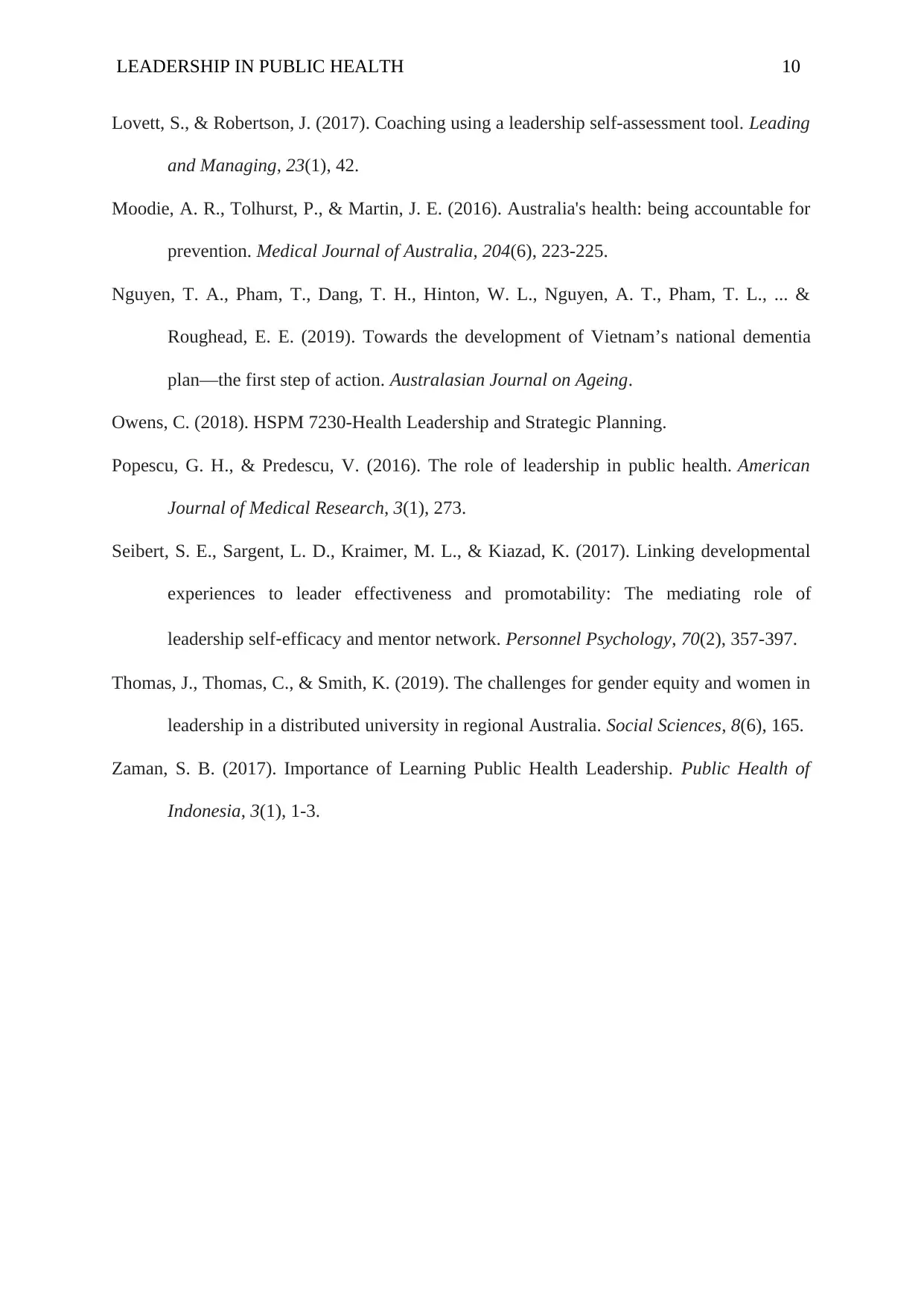
LEADERSHIP IN PUBLIC HEALTH 10
Lovett, S., & Robertson, J. (2017). Coaching using a leadership self-assessment tool. Leading
and Managing, 23(1), 42.
Moodie, A. R., Tolhurst, P., & Martin, J. E. (2016). Australia's health: being accountable for
prevention. Medical Journal of Australia, 204(6), 223-225.
Nguyen, T. A., Pham, T., Dang, T. H., Hinton, W. L., Nguyen, A. T., Pham, T. L., ... &
Roughead, E. E. (2019). Towards the development of Vietnam’s national dementia
plan—the first step of action. Australasian Journal on Ageing.
Owens, C. (2018). HSPM 7230-Health Leadership and Strategic Planning.
Popescu, G. H., & Predescu, V. (2016). The role of leadership in public health. American
Journal of Medical Research, 3(1), 273.
Seibert, S. E., Sargent, L. D., Kraimer, M. L., & Kiazad, K. (2017). Linking developmental
experiences to leader effectiveness and promotability: The mediating role of
leadership self‐efficacy and mentor network. Personnel Psychology, 70(2), 357-397.
Thomas, J., Thomas, C., & Smith, K. (2019). The challenges for gender equity and women in
leadership in a distributed university in regional Australia. Social Sciences, 8(6), 165.
Zaman, S. B. (2017). Importance of Learning Public Health Leadership. Public Health of
Indonesia, 3(1), 1-3.
Lovett, S., & Robertson, J. (2017). Coaching using a leadership self-assessment tool. Leading
and Managing, 23(1), 42.
Moodie, A. R., Tolhurst, P., & Martin, J. E. (2016). Australia's health: being accountable for
prevention. Medical Journal of Australia, 204(6), 223-225.
Nguyen, T. A., Pham, T., Dang, T. H., Hinton, W. L., Nguyen, A. T., Pham, T. L., ... &
Roughead, E. E. (2019). Towards the development of Vietnam’s national dementia
plan—the first step of action. Australasian Journal on Ageing.
Owens, C. (2018). HSPM 7230-Health Leadership and Strategic Planning.
Popescu, G. H., & Predescu, V. (2016). The role of leadership in public health. American
Journal of Medical Research, 3(1), 273.
Seibert, S. E., Sargent, L. D., Kraimer, M. L., & Kiazad, K. (2017). Linking developmental
experiences to leader effectiveness and promotability: The mediating role of
leadership self‐efficacy and mentor network. Personnel Psychology, 70(2), 357-397.
Thomas, J., Thomas, C., & Smith, K. (2019). The challenges for gender equity and women in
leadership in a distributed university in regional Australia. Social Sciences, 8(6), 165.
Zaman, S. B. (2017). Importance of Learning Public Health Leadership. Public Health of
Indonesia, 3(1), 1-3.
1 out of 10
Related Documents
Your All-in-One AI-Powered Toolkit for Academic Success.
+13062052269
info@desklib.com
Available 24*7 on WhatsApp / Email
![[object Object]](/_next/static/media/star-bottom.7253800d.svg)
Unlock your academic potential
Copyright © 2020–2025 A2Z Services. All Rights Reserved. Developed and managed by ZUCOL.



